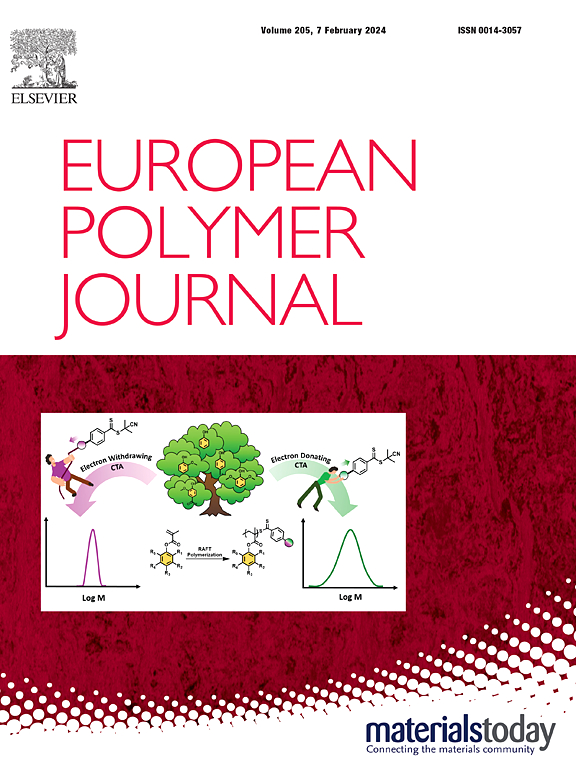Preparation of polyhydroxy hydrophilic chromatographic stationary phases for alginate oligosaccharide separation
IF 5.8
2区 化学
Q1 POLYMER SCIENCE
引用次数: 0
Abstract
To solve the problem of poor selectivity of oligosaccharide separation, a new functionalized silica stationary phase, SPTM(THMA-co-MBAAm), was prepared with N-[tris(hydroxymethyl)methyl]acrylamide (THMA) and N,N-methylenebisacrylamide (MBAAm) containing hydroxyl groups as functional monomers. This stationary phase was used to do hydrogen bonding-based oligosaccharide compound separation. The stationary phase SPTM was successfully prepared, and the functional monomers were bonded onto an SiO2 matrix. The separation of nucleobases and nucleosides on SPTM conformed to the multiple retention mechanism (i.e., a distribution mechanism supplemented by an adsorption mechanism). As a result of the hydrophilic hydroxyl groups on the outermost layer of the phase of stagnation, a layer rich in water was created. The bonds of hydrogen and electromagnetic attraction in addition to repulsion were additionally involved in retention. SPTM was applied to the separation of samples of alginate oligosaccharides with optimized mobile-phase conditions.

海藻酸盐低聚糖分离用多羟基亲水性色谱固定相的制备
为解决寡糖分离选择性差的问题,研究人员以含羟基的 N-[三(羟甲基)甲基]丙烯酰胺(THMA)和 N,N-亚甲基双丙烯酰胺(MBAAm)为功能单体,制备了一种新型功能化硅胶固定相 SPTM(THMA-co-MBAAm)。该固定相用于基于氢键的寡糖化合物分离。成功制备出固定相 SPTM,并将功能单体键合在二氧化硅基质上。核碱基和核苷在 SPTM 上的分离符合多重保留机制(即分布机制辅以吸附机制)。由于停滞相最外层的亲水性羟基,形成了一个富含水的层。除了斥力之外,氢键和电磁吸引也参与了保留。在优化的流动相条件下,将 SPTM 应用于海藻酸寡糖样品的分离。
本文章由计算机程序翻译,如有差异,请以英文原文为准。
求助全文
约1分钟内获得全文
求助全文
来源期刊

European Polymer Journal
化学-高分子科学
CiteScore
9.90
自引率
10.00%
发文量
691
审稿时长
23 days
期刊介绍:
European Polymer Journal is dedicated to publishing work on fundamental and applied polymer chemistry and macromolecular materials. The journal covers all aspects of polymer synthesis, including polymerization mechanisms and chemical functional transformations, with a focus on novel polymers and the relationships between molecular structure and polymer properties. In addition, we welcome submissions on bio-based or renewable polymers, stimuli-responsive systems and polymer bio-hybrids. European Polymer Journal also publishes research on the biomedical application of polymers, including drug delivery and regenerative medicine. The main scope is covered but not limited to the following core research areas:
Polymer synthesis and functionalization
• Novel synthetic routes for polymerization, functional modification, controlled/living polymerization and precision polymers.
Stimuli-responsive polymers
• Including shape memory and self-healing polymers.
Supramolecular polymers and self-assembly
• Molecular recognition and higher order polymer structures.
Renewable and sustainable polymers
• Bio-based, biodegradable and anti-microbial polymers and polymeric bio-nanocomposites.
Polymers at interfaces and surfaces
• Chemistry and engineering of surfaces with biological relevance, including patterning, antifouling polymers and polymers for membrane applications.
Biomedical applications and nanomedicine
• Polymers for regenerative medicine, drug delivery molecular release and gene therapy
The scope of European Polymer Journal no longer includes Polymer Physics.
 求助内容:
求助内容: 应助结果提醒方式:
应助结果提醒方式:


